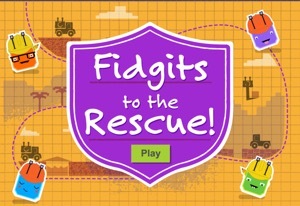Q1. What is Design Thinking? Introduction
Introduction
In this Quest, you will use design thinking to identify people's needs and identify their problems.
Design thinking tends to work really well for creating solutions to problems that impact humans because it focuses on finding the best ways to address people's needs.
Creating a new type of food that can be distributed to areas with food shortages, a new type of transportation for people in big cities, or a YouTube channel that inspires others to be their best selves are all examples of using design thinking.
I CAN STATEMENTS
- create a team with varying backgrounds and strengths
- explain the different stages of the design thinking process
Defining a Problem Using the Fidgits to the Rescue Game
1. Check with your teacher about working with a partner or small group and how many minutes you will have to play before Pausing to discuss the following questions. Select one of your classmates to be the one to open and run the game.
Discussion Questions:
- What problems are you encountering in the game?
- What are the needs of the person driving the truck?
- What are the best solutions you think of that help the person in the truck?
- Are there times your first design did NOT work? What did you do?
2. Ready - Set - Go : Link to Fidgits to the Rescue

Competencies & Standards
MITECS Michigan Integrated Technology Competencies for Students, and
1. Empowered Learner
b. build networks and customize their learning environments
in ways that support the learning process
4. Innovative Designer
a. Know and use a deliberate design process for generating ideas, testing theories, creating innovative artifacts or solving authentic problems
b. Select and use digital tools to plan and manage a design process that considers design constraints and calculated risks
7. Global Collaborator
b. use collaborative technologies to work with others, including peers, experts or community members, to examine issues and problems from multiple viewpoints
c. contribute constructively to project teams, assuming various roles and responsibilities to work effectively toward a common goal
d. explore local and global issues and use collaborative technologies to work with others to investigate solutions
6. Creative Communicator
a. Choose the appropriate platforms and tools for meeting the desired objectives of their creation or communication
Websites and Documents
Websites
- Engineering Design Process
- Fidgits to the Rescue
- Source #1: Teen-Created Software IDs Skin Conditions, Risky Drivers and More
- Source #2: Virginia High School Student Creates Soap to Fight Skin Cancer
- Scientific Method
Videos from Outside Sources
21t4s Videos
21t4s Documents & Quizzes
21t4s Digital Breakout Challenge




